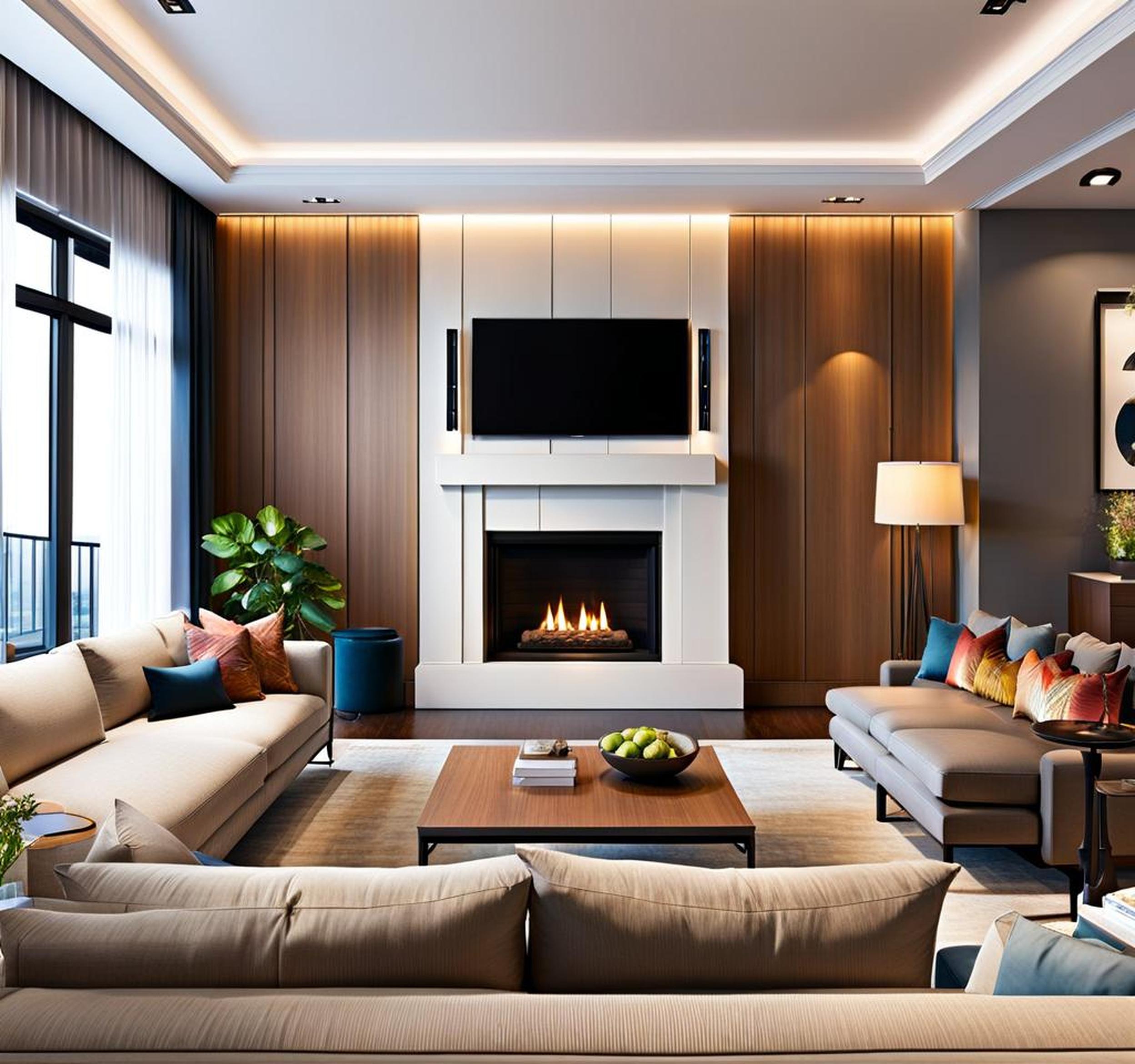Designing a living room with both a TV and fireplace can seem challenging at first. However, with some strategic planning and creativity, you can create a space that seamlessly incorporates these two focal points. The key is finding the right balance between practical media viewing and inviting conversational areas.
Placement Options for the TV in Relation to Fireplace
One of the first decisions to make is where to locate the TV relative to the fireplace. The two most common options are mounting above the fireplace or positioning on an adjacent wall. Each has distinct pros and cons to weigh.

Mount TV Above Fireplace
Placing the TV over the fireplace mantel is a layout that saves floor space. However, it also comes with some potential drawbacks. Looking up at the TV from most seated positions can lead to neck strain over time. Carefully selecting the right TV type and mounting height helps minimize these issues.
When mounting a TV above a fireplace, pay close attention to the ideal viewing angle and height. Look for TV mounts with articulating swing arms that allow adjusting the screen angle. Make sure to install the TV at eye level when seated for the most comfortable long-term viewing.
Because a TV above the fireplace is at a higher vantage point than usual, select a unit with a slim, streamlined profile. New ultra-thin frame TVs are ideal choices that practically disappear into the wall when not in use. Mounting the components behind the TV helps reduce visible clutter. Consider a model with art display mode to showcase attractive imagery when you don’t need the screen.
To enhance the look around a fireplace TV setup, incorporate complementary decorative accents. Hang matching framed artwork or mirrors on either side at balanced heights. Conceal cables inside the wall or mantle to prevent messy dangling wires.
Position TV on Adjacent Wall
Putting the television on a side wall is another option that offers its own set of upsides. You avoid potential fire hazards and overheating that can occur from mounting above the fireplace. A side wall also allows for a more ergonomic, lower TV height without neck craning.
When it comes to TV stands for side wall placement, a media console or shelving unit blends seamlessly. For a streamlined aesthetic, try mounting the TV on a wall and installing a floating shelf underneath to hold components. This helps create the illusion of the TV hovering in midair.
To make a side wall TV zone cohesive with the rest of the living room decor, use corresponding design elements. Position furniture to face the television wall naturally. Flank the TV area with matching cabinets, shelving, or built-ins for symmetry. An easy idea is installing floor-to-ceiling drapes behind the TV area to define a functional yet attractive viewing zone.
Furniture Arrangement Tips
Once you decide on TV and fireplace placement, next comes arranging furnishings in a way that promotes open flow while delineating specific spaces.
Create Defined Spaces
When incorporating both media viewing and conversation areas in an open concept living room, using furniture to create defined zones helps. Think about dividing the space into multiple functional areas like a TV/media zone, seating for conversation, and even a cozy reading nook.
Sofas or sectional configurations work perfectly to anchor conversation spaces. Make sure to position them at natural angles that facilitate interacting. Swivel chairs allow easily alternating between viewing the television and conversing with others in the room. Lastly, tuck a small, comfortable chair with an end table into a corner to create a quiet spot for reading.
Allow Open Flow
While designated spaces are useful, you don’t want the living room to feel fragmented. Implement design strategies to foster an interconnected feel. Pull furnishings away from the walls and avoid pushing everything against the perimeter. Leaving ample walking space between furniture pieces also prevents a cramped appearance.
For a more spacious ambiance, opt for smaller-scale furnishings. Loveseats take up less visual real estate than oversized sofas. Narrow rectangular coffee tables or ottomans leave room to circulate. Compact media consoles prevent dominating large wall expanses.
Incorporate Multifunctional Pieces
Making every piece work double duty is an efficient approach in smaller living rooms. Seek out furniture that moonlights for multiple uses.
Ottomans on casters can easily alternate between serving as extra seating or coffee tables. Nesting tables provide surface space as needed but tuck away discreetly when not in use. Some desks feature fold-down work surfaces to convert quickly into dining tables or concealed storage.
When introducing multifunctional furnishings, ensure they complement the intended style. Focus on solid craftsmanship that allows for frequent transitions. And seek out designs with ingenious transformations between uses – a coffee table with lift-top storage or an ottoman that reveals hidden serving trays for entertaining.
If the prospect of arranging a living room with both fireplace and TV has you stumped, keep these pointers in mind. Carefully weigh the pros and cons of placement options for the television. Use furniture to delineate functional spaces while maintaining an open flow. Seek out smaller-scale and multifunctional furnishings tailored to your aesthetic. With some advance planning and creative thinking, you can craft a living room layout perfect for gathering around the fire or watching the big game.
The key is finding balance between practical needs like media viewing and creating an inviting ambiance for conversation. Proper furniture arrangement can help prevent the TV and fireplace from competing. Integrating these elements into a holistic, well-designed space results in a living room perfect for quality time with family and friends.
